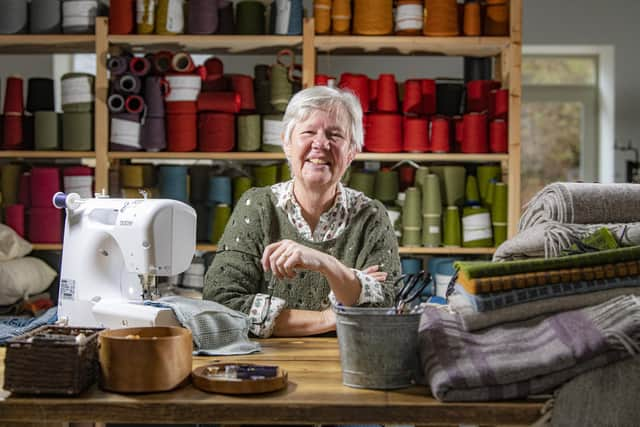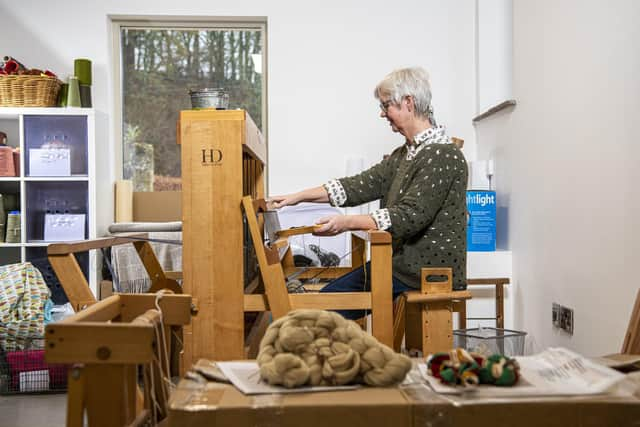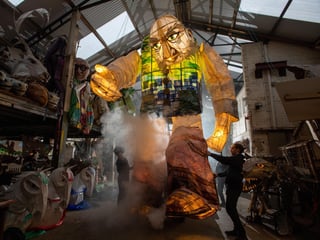Laura's Loom - combining the best of British wool with Yorkshire know-how
the wool that ends up in scarves and blankets produced by Laura’s Loom or Laura Rosenzweig herself, an artisan weaver and former cartographer who has ventured from Yorkshire to the US and back again via Switzerland, with loom in tow.
Last June she moved from Farfield Mill in Sedbergh to a studio at Kirkby Lonsdale on the western fringe of the Yorkshire Dales. One loom, her first which she brought over from the States, has pedals like a church organ with the added operational challenge of leaning forward to throw the shuttle from side to side.
Advertisement
Hide AdAdvertisement
Hide AdA new six-foot loom, equally as complicated with a bewildering web of heddles and threads, is powered by what looks like an exercise bike. Both devices are mechanical and there’s barely a computer in sight. Reels of yarn are set out on the floor in themed colour groups, some inspired by the blues and greens of the Dales, as the early stage of the design process.


Recent items in production were shooting sock ties for the mother-in-law of Laura’s new landlord.
Laura is passionate about wool, weaving and provenance. She sources all her fleeces – around 500 every year – direct from local farmers. “Sheep are sheared in July and August and I collect fleeces in September and October and get them sorted, taking off spots of dung which are good for the garden,” she says.
“I wait for a nice day and do it all outside. I really like talking to farmers and knowing exactly where my yarn has come from. That’s really important to me. What galvanised me into doing this is that when we moved to Sedbergh, I was looking around at sheep everywhere and thinking I’m a weaver and surely I can do something with this wool.
Advertisement
Hide AdAdvertisement
Hide Ad"That was when farmers were burning their wool because they were getting nothing for it. Wool is such a wonderful, natural material and I thought why does it have no value and can’t I put value back into it? I was really interested in how to create good weaving yarn that could be turned into woven cloth, particularly blankets which few people were producing.”


She says different breeds produce fleeces that suit different products. “Bluefaced Leicester sheep produce wool that is fine and light but still warm and not scratchy, which makes it ideal for blankets. Socks need yarn that’s a bit more robust as they wear through quickly.
"My Hebridean wools were perfect, especially when we blended some Shetland into it to get different colours. Farmers started asking me ‘do you want a bit of this?’ and I was getting home to find a bit of anonymous fleece on my porch. I had so many pieces I put them all together.”
Laura started as a hand craft weaver using silk and merino wool making one piece at a time but, over the last 10 to 12 years has branched into other less fine wools. She now also manages the conversion of her fleeces and yarn into products made by mills. In fact, this larger-scale side of her business now accounts for about 90 per cent of turnover.
Advertisement
Hide AdAdvertisement
Hide AdFirst her fleeces are scoured, a laundering and drying process, by Haworth Scouring and Thomas Chadwick, both of Bradford. Spinning, by which fibres are combed, twisted and made into yarn, is undertaken by Lightowlers Yarns, of Meltham, near Huddersfield. Laura then sends yarns to four mills in the Scottish Borders for dying, weaving and cloth finishing. She produces about 100 blankets and 150 scarves per year in this way, based on her designs and samples woven on her looms.
“I’m a bit of a production weaver and a bit of an artisan, craft bespoke weaver. One of the reasons I bought the new loom is to get back to weaving. I’m a weaver at heart but I call myself a logistics manager. I have friends who help with bits and pieces of the business like sewing on labels but the actual management of the business is just by me.”
Laura grew up in Goole and studied regional planning at the University of Pennsylvania from 1986 and then moved to Rhode Island and Boston to work in environmental management. While she was there, she met a weaver in a knitting wool shop, tried it for herself and was instantly hooked. The weaver taught Laura for a year and ultimately inspired her business. She bought the US loom that now stands in her studio 27 years ago. Her first project was a baby blanket for her son.
She and husband Phil moved to Switzerland with his work in 1996. “I was raising our children at the time and wove to stay sane. I began selling items to friends, went to craft fairs and got commissions. When we moved to Sedbergh in 2002, I decided to see if I could build something from my hobby. I quickly learnt that it’s hard to sell enough to make money to pay the rent. It can take three days to make one scarf.
Advertisement
Hide AdAdvertisement
Hide Ad"I started to wonder how I could make it pay as I wanted to carry on. I also didn’t want to be at home as I was in a new town and didn’t know anybody. For a long time I resisted getting bigger as I didn’t want to lose sight of why I started this in the first place, which is to produce lovely woven items from British wool. A friend who was a painter was struggling in a similar way. She had resisted having her paintings turned into prints but eventually decided to do so to make some money. She said that I could consider my handwoven pieces like my oil paintings and mill-woven pieces as my prints.”
Laura studied on a two-year programme for hand-woven design at Bradford College to improve her design skills. “As a scientist, I like the technical aspect of weaving. Most of my previous professional work was involved with computerised cartography. The need for attention to detail when working with computers and data analytics also applies to weaving.
"You have to thread every thread individually by hand in a certain pattern and concentrate. If you get it wrong, sometimes you have to do it all over again. I like sitting, threading and setting up the loom, thinking about how the finished piece is going to look and feel. A map has to look good so that people read it but the main work that goes into it is the science of putting all the data in the right way so that it comes out correctly. So I see a lot of parallels between what I did as a professional and what I do now.”
Inspiration comes from many sources. Laura designed a scarf for a friend’s birthday based on a walk they shared in Scotland, the hues representing the mist, heather, bracken, loch, and sky. A commission for a blanket was based on colours in a client’s favourite painting. During lockdown, a customer from Canada bought a blanket for her sister from LA to remind her of their Yorkshire roots and lift her spirits.
Advertisement
Hide AdAdvertisement
Hide AdSimilarly, Laura received an online commission from a British customer in New Zealand who, unable to get back to the UK, wanted a blanket made from Bluefaced Leicester wool to remind her of home.
“There are moments like when I’m hauling bags of wet fleece around when I think ‘why am I doing this?’ If I say that out loud my family and friends say ‘because you love it’.
"I feel really fortunate to be able to come to a place like this and do what I want to do every day and make things that people really seem to appreciate.”
www.laurasloom.co.uk
Comment Guidelines
National World encourages reader discussion on our stories. User feedback, insights and back-and-forth exchanges add a rich layer of context to reporting. Please review our Community Guidelines before commenting.
